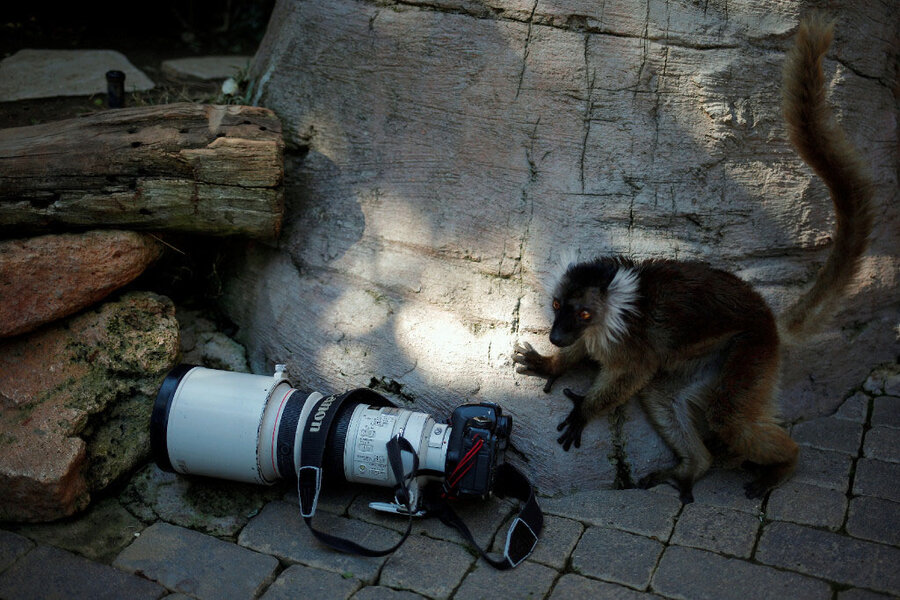How facial-recognition software is helping protect endangered lemurs
Loading...
Observing lemurs in the jungles of Madagascar is no easy task.
“We find the group,” explains Stacey Tecot, an assistant professor at the University of Arizona’s School of Anthropology, “and then we watch them for a little bit, we get our bearings ... and then we start to collect our data.”
Doing so is an all-day process of recording each individual, more or less continuously. But lemurs typically live in “troops” of up to 15 individuals. To get solid data, Dr. Tecot tells The Christian Science Monitor in a phone interview, “you really have to know that who you're watching is who you think you're watching.”
Biologists usually tell individuals apart using distinctive traits such as scars, or give them tags or radio collars. But in a recent study, scientists tested an easier, higher-tech way to keep track of lemurs: facial-recognition software.
“This is completely non-invasive,” says Tecot, one of two senior authors of a paper published Friday that describes the study. “It's something that can be used during training so everyone can learn who individuals are, but then also make sure that you're being accurate in your identification.”
Using a database of faces also makes it possible to track individuals as they enter and leave a population, “so there's implications for long-term research as well.”
Tecot explains that she and the paper’s other lead author, Rachel Jacobs, both struggled to distinguish lemurs in the course of their research. They began exploring non-invasive means to identify different lemurs, and “face-recognition just kept coming back, because they have such distinct faces, and color patterns.”
After reading about the work of Anil Jain, a computer science professor at Michigan State University whose work focuses on biometrics and face recognition, “we realized this is something that was actually possible.”
While facial-recognition programs help Facebook tag photos and police identify suspects, adapting the systems to a different primate proved challenging. “The texture characteristics of the human skin is different from that of the lemur skin,” Professor Jain tells the Monitor in a separate interview. “There's a lot more facial hair.”
The team taught their program, called LemurFaceID, using a “training database” of 462 photos of 80 different red-bellied lemurs.
Over the course of 100 trials, the system recognized individuals correctly 98.7 percent of the time, with about a 2-percent margin of error. Jain expects its accuracy to improve further as it analyzes more images.
Ultimately, the study’s authors aim to bring this system to the field. “Really the idea is that it could be an app in the mobile phone, and the field worker, instead of [needing] a bulky laptop, or a camera, can just point the mobile phone camera towards the lemur, and know whether we have seen the lemur before,” Professor Jain tells the Monitor.
He points out that many Android phones already have facial-recognition capability for humans. Bringing LemurFaceID to the platform is “a question of resources and time.”
Population counts and observation data are seen as a necessary part of conservation efforts for species ranging from birds to frogs. Lemurs are also in dire need of protection: Twenty-six members of the genus lepilemur are currently on the International Union for the Conservation of Nature’s “Red List” of threatened and endangered species. In 2015, the BBC reported that hunting and deforestation could wipe out wild lemurs within 25 years.
If deployed, LemurFaceID could help reverse this trend. “This could be used by all different kinds of people,” says Tecot, “including anyone who's tracking wildlife trafficking or something like that.”
But while the animals’ plight creates a clear need for better research tools, new technologies present a learning opportunity for scientists in Madagascar, where lemurs make their home.
As Dr. Tecot explains, “our long-term plan is to work with the ecological monitoring team in Madagascar that's run by Malagasy researchers and continue to build the database and develop the software, as well as help train people in how to manipulate and adapt these algorithms for other species.”








